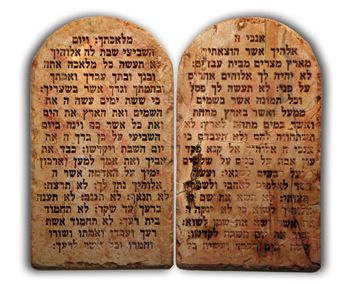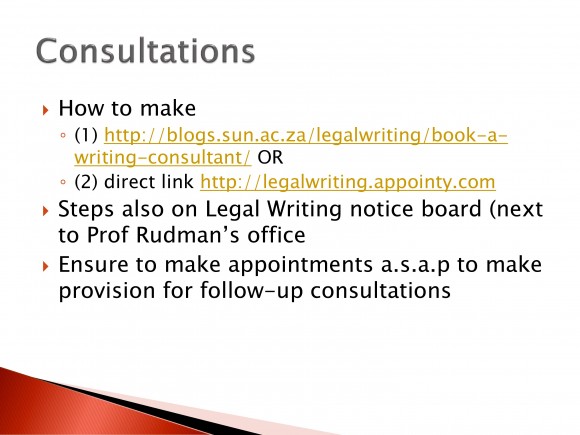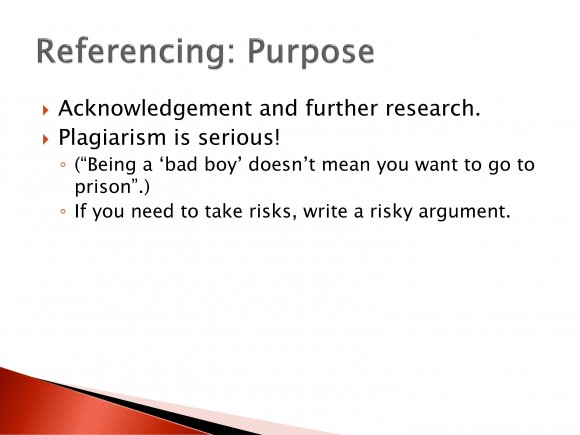
by Chantelle | May 5, 2014 | Strategic Legal Writing
Dear Students / Beste Studente
Ek kom agter dat julle baie sukkel met julle Bibliografie en die verwysing na bronne daarin. Dit word volledige beskryf in die Skryfgids (bladsy 49), maar vir maklike vewysing haal ek slegs die verduideliking ten opsigte van die uitleg daarvan hieronder aan. / I find that a lot of you struggle with your Bibliography and the correct citation of references therein. It is explained in full in the Writing Guide (page 43), but for ease of reference I have copied the explanatory notes with regard to the Bibliography hereunder.
BIBLIOGRAFIE
Al die bronne waarna jy verwys, moet aan die einde van jou werkstuk volledig in ʼn bibliografie verskyn. Moenie bronne by die bibliografie insluit indien jy nie in die teks daarna verwys nie. Die volgende gegewens moet oor die algemeen verstrek word:
- die naam van die outeur/redakteur van die werk (eerste outeur se voorletter na; tweede en verdere outeurs se voorletters voor vanne;
- die volledige titel van die artikel/boek;
- datum van publikasie in hakies;
- volumenommer van die betrokke regstydskrif;
- die volledige titel van die tydskrif;
- die uitgewer (van ’n boek);
- bladsynommers van die betrokke artikel of hoofstuk in die boek.
Skep ’n itemlys met opskrifte, kyk na die eerste outeur se van en sorteer alfabeties onder die opskrif.
Voorbeelde:
| Boeke:
Currie I & J de Waal The Bill of Rights Handbook 5 uitg (2005), Juta & Co.Klaaren J (red) A Delicate Balance: The Place of the Judiciary in a Constitutional Democracy (2006), SiberInk.
Hoofstukke in geredigeerde boeke:
Tushnet M “Comparative Constitutional Law” in A Reimann & R Zimmerman (eds) The Oxford Handbook of Comparative Law (2006) 1225-1230, Oxford University Press.
Losbladpublikasies:
Roux T “Democracy” in S Woolman, T Roux, M Bishop (eds) Constitutional Law of South Africa 2 ed (RS 1 2009) 10-3-10-22.
Proefskrifte:
Scott S Unjust Enrichment by Transfer in South African Law: Unjust Factors or Absence of Legal Ground? DPhil thesis Oxford University (2005).
Amptelike publikasies:
RSA First Report of the Constitutional Committee of the President’s Council PC 3/1982 112-115.
Ongepubliseerde bronne:
LM du Plessis The Courts, the Legal Profession and the Legal Process in a future South Africa (1989) ongepubliseerde referaat gelewer by ’n kongres oor A new Jurisprudence for a Future South Africa aangebied deur die Sentrum vir Menseregte Studies by die Universiteit van Pretoria, 26-10-1990.
Regstydskrifartikels:
Albertyn C & B Goldblatt “Facing the Challenge of Transformation: Difficulties in the Development of an Indigenous Jurisprudence of Equality” (1998) 14 SAJHR 248.
Gedrukte media:
Du Plessis LM “SA Howe – Grammofone of Politieke Kanaalgrawers?” Rapport (18-05-1986) 23.
Sake:
Government of the Republic of South Africa v Grootboom 2001 1 SA 46 (CC).
Wetgewing:
Strafproseswet 51 van 1977.
Internet:
Kornet N “Contracting in China: Comparative Observations on Freedom of Contract, Contract Formation, Battle of Forms and Standard Form Contracts” (2010) 14 Electronic Journal of Comparative Law 1 3-4 ˂http://www.ejcl.org/141/art141-1.pdf>. |
BIBLIOGRAPHY
All the sources to which you refer must be comprehensively described in a bibliography at the end of the assignment. This generally includes –
- the name(s) of the author(s)/editor(s) of the work;
- the full title of the article/book;
- date of publication in brackets;
- the volume number of the relevant law journal;
- the full title of the journal;
- the publisher (of a book);
- page number(s) of the relevant article or chapter in the book.
Order items per type under headings and alphabetically per first author’s surname within headings.
Examples:
| Books:
Currie I & J de Waal The Bill of Rights Handbook 5 ed (2005), Juta & Co.Klaaren J (ed) A Delicate Balance: The Place of the Judiciary in a Constitutional Democracy (2006), SiberInk.
Edited Collections:
Tushnet M “Comparative Constitutional Law” in A Reimann & R Zimmerman (eds) The Oxford Handbook of Comparative Law (2006) 1231-1233, Oxford University Press.
Loose-leaf publications:
Roux T “Democracy” in S Woolman, T Roux, M Bishop (eds) Constitutional Law of South Africa 2 ed (RS 1 2009) 10-3-10-22.
Theses or dissertations:
Scott S Unjust Enrichment by Transfer in South African Law: Unjust Factors or Absence of Legal Ground? DPhil thesis Oxford University (2005).
Official publications:
RSA First Report of the Constitutional Committee of the President’s Council PC 3/1982.
Unpublished sources:
Du Plessis LM The Courts, the Legal Profession and the Legal Process in a Future South Africa (1989) unpublished paper presented at a conference on A New Jurisprudence for a Future South Africa hosted by the Centre for Human Rights Studies at the University of Pretoria 26-10-1990.
Law Journal articles:
Albertyn C & B Goldblatt “Facing the Challenge of Transformation: Difficulties in the Development of an Indigenous Jurisprudence of Equality” (1998) 14 SAJHR 248.
Printed media:
Du Plessis LM “SA Howe – Grammofone of Politieke Kanaalgrawers?” Rapport (18-05-1986) 23.
Cases:
Government of the Republic of South Africa v Grootboom 2001 1 SA 46 (CC).
Legislation:
Criminal Procedure Act 51 of 1977.
Internet:
Kornet N “Contracting in China: Comparative Observations on Freedom of Contract, Contract Formation, Battle of Forms and Standard Form Contracts” (2010) 14 Electronic Journal of Comparative Law 1 3-4 ˂http://www.ejcl.org/141/art141-1.pdf>. |

by Chantelle | May 1, 2014 | Strategic Legal Writing
THE HISTORY OF LEGAL WRITING – by Piet Kotzé
Introduction to legal writing
Legal writing can refer to at least two things. Firstly, to any writing related to law and secondly, to the skill and principles underlying writing in a legal context. Both will be discussed.
South African Legal History
In order to get an idea of legal writing in the South African context it is necessary to give a short history of the development of South African law.
Overview
The law as it is today is the result of a natural process of “hand-me-downs” and the comparative law approach. From Roman law through its development over the centuries through its reception into and development as Roman-Dutch law to its application in South Africa. English law, itself influenced by Roman law, also had a major impact on our law.
Examples
Here are a few examples of early legal writing. The first recorded law was the command given by God to Adam which forbade him from eating of the tree of the knowledge of good and evil. If the Biblical records are correct then Adam and Eve were also the first two people on earth. This means, unless Adam created some law which applied only to himself . . . the above-mentioned law was also the very first.
Biblical
In the second book of the Bible, Exodus, the story of the Ten Commandments is told. The law was written on two stone tablets by God Himself. These laws were to govern the conduct of all people. In Jeremiah 32, we also read the story of the sale of a field with the corresponding documents. This occurred at the time of King Nebuchadnezzar II when he laid siege to Jerusalem. Scholars date the events to about 587 BC.

The code of Hammurabi and Mosaic law
The code of Hammurabi is a law code from ancient Babylon named after the king. It set out, among other things, building regulations. It dates to 1780 BC. Although it is regarded as the most important “legal compendium of the ancient Near East” it is predated by two Sumerian sources, one by Ur-Namma, King of Ur in 2100 BC and the other by Lipit-Ishtar of Isin in 1930 BC.*
* Jacques Loubscher “Tracing the origins of the Southern African building regulations, with specific reference to the period between 1650 and circa 1740: review article” available at http://reference.sabinet.co.za/document/EJC110061.
The code’s view on slavery is in sharp contrast to the Mosaic law. The code mandates the death penalty to the master of a house in which a runaway slave is harboured. The Mosaic law forbids the return of such a slave who fled from his master because of oppression or cruelty. See Deuteronomy 23:15.
The code’s view on the treatment of slaves is more similar to the prevailing European laws of recent centuries than to the Mosaic law. In that respect the last-mentioned law was unique in the ancient near east and, generally speaking, even compares well with modern moral standards.
European law
Until codification occurred one could speak of European legal scholarship. With this change, law was studied more confined to nationality and developed a distinct local flavour.
*The Common History of European Legal Scholarship “Erasmus University Rotterdam: law Review” http://www.erasmuslawreview.nl/files/The_Common_History_of_European_Legal_Scholarship.
Legal Writing as an Academic Exercise
The first United States legal writing course to be offered at university level started in the late 1950s in the form of a class. It was offered by third year students and managed by one faculty member, usually the law librarian. It grew in the early sixties to be offered by, then, recent graduates and later by practitioners with one or two years’ experience. The turnover was high and people doing the work stayed in the positions for no more than two years each. The doctoral staff were also under the impression that because of the workload no one would want to continue this work indefinitely and so placed caps on potential development in these positions. This worsened the situation.
In South Africa legal writing training is still in its infancy. Stellenbosch University has made great strides by the introduction of the current programme. It is an ongoing process and will be fine-tuned to better equip the students for the challenges they may face in future. The father of this project is Geo Quinot, Departmental Chair and Professor in Public Law.*
* http://blogs.sun.ac.za/law/staff/publiekreg-public-law/prof-geo-quinot/
What to expect of legal writing in future
When you do PLT you will notice that the guides specifically mention that certain words and phrases have become obsolete and should be substituted with shorter, clearer ones. When studying for your admission examinations take note that some of the older questions may be repeated in new papers, but that the answers have changed. They now only use plain language. This is a great improvement and much easier to remember.
Skill and principles
“[L]anguage is the central tool of our trade . . . we depend heavily on the lawyers. Our chance to get a case right improve to the extent the lawyers do a better job . . . You don’t have a lot of confidence in the substance if the writing is bad. . .”
To the question, “[w]hat would you identify as the periods in your life when you underwent growth spurts as a writer?” he answered, “you develop a lot as a writer the more you read and so whenever I was having a lot of time to read I think I would have improved a lot as a writer . . . the interesting thing is . . . people lose a lot of writing ability when they get to law school because [they] tend to read a lot of [things] that aren’t that well written and . . . stop reading other [things] that are well written . . . perhaps law students should make sure they have enough time to read [things] apart from law throughout law school” – Justice Roberts (United States Supreme Court).
South Africa is not completely isolated and the national LLB curriculum has recently come under fire for the poor writing performance of graduates. For more on this topic, read the article “The need for a legal-writing course in the South African LLB curriculum” available at http://reference.sabinet.co.za/document/EJC125384.

by Chantelle | Apr 21, 2014 | Strategic Legal Writing
Reaksie op die skrapping van die LLB (4 jarige) graad deur die Universiteit van die Witwatersrand. Die Fakulteit Regsgeleerdheid van Stellenbosch Universiteit het kennis geneem van mediaberigte rakende die besluit van die Universiteit van die Witwatersrand om nie voortaan die vierjarige voorgraadse LLB program aan te bied nie. Die Stellenbosse Regsfakulteit bevestig dat die vierjarige LLB graad wat deur die Fakulteit aangebied word nie deur die besluit van die Universiteit Witwatersrand geraak word nie en dat daar tans geen planne is om die program te skrap nie. Die Fakulteit volg ʼn holistiese perspektief waardeur deeglike rekening gehou word met die vaardighede waaroor studente beskik, asook die behoeftes van die werkswêreld. Dit volg dus logies dat daar deurlopend krities na die inhoud van al die verskillende regsgrade, naamlik die LLB (4 jaar), LLB (2 jaar nagraads), LLB (3 jaar nagraads), BRekLLB, BCom (Regsgeleerdheid) en BA (Regsgeleerdheid) gekyk word. Die Fakulteit wil beklemtoon dat die inhoud van die regsvakke in die verskillende regsgrade presies dieselfde is ongeag die program wat gevolg word. Die Fakulteit Regsgeleerdheid van die Stellenbosch Universiteit volg verder ʼn streng keuring waar net die beste aansoekers tot die verskillende programme toegelaat word en enige student wat afstudeer kan weet dat hy of sy ʼn deeglike teoretiese begronding in die reg het. Die Fakulteit is verbind tot die proses van regshervorming ten opsigte van regsonderrig wat nasionaal plaasvind. Dit is ʼn proses wat tyd en deeglike besinning verg. Elke Fakulteit is uniek, nie net wat visie betref nie, maar ook die studentekorps. Hierdie Fakulteit beskou steeds die vierjarige LLB program as ‘n waardevolle deel van sy aanbod wat regsgeleerdes van hoë gehalte aflewer. —————————————————————————– Reaction to the discontinuation of the 4 year LLB programme at the University of Witwatersrand. The Faculty of Law of Stellenbosch University noted the decision of the University of the Witwatersrand reported in the media to discontinue its offering of the four-year undergraduate LLB programme. The Stellenbosch Law Faculty confirms that the 4 year LLB (Bachelor of Laws) programme offered by the Faculty will not be affected by the decision taken by the University of Witwatersrand and that there are currently no plans to discontinue this programme. The Faculty follows a holistic perspective taking into account its students’ skills, as well as the needs of the work environment. It therefore logically follows that the contents of the various law degrees, namely the LLB (4 year), LLB (2 year postgraduate), LLB (3 year postgraduate), BAccLLB, BCom (Law) and BA (Law) degrees, offered by Stellenbosch University is critically evaluated on an ongoing basis. The Faculty wishes to emphasise that the contents of the law modules in the various law degrees is identical irrespective of the programme that a student follows. The Faculty of Law of Stellenbosch University furthermore follows a strict selection process of applicants for the various programmes, where only the best applicants are admitted to the programmes and any student that completes their degree can be sure that he or she has a thorough theoretical grounding in the law. The Faculty is committed to the reform process in legal education, which is taking place on national level. This process takes time and requires thorough consideration. Each faculty is unique, not only in respect of the vision of the faculty, but also in terms of its student body. The Faculty of Law at Stellenbosch University considers the four-year LLB programme as a valuable part of its offering that delivers law graduates of high calibre.

by Chantelle | Apr 11, 2014 | Strategic Legal Writing
Beste Studente / Dear Students
Hier is ’n kort kontrolelys wat jy kan gebruik om seker te maak dat jou werkopdrag voldoen aan die meeste tegniese punte. Gebruik die kontrolelys elke keer nadat jy ’n werkopdrag voltooi het en voordat jy dit druk.
Herewith a short checklist that you can use to ensure that your assignment comply with most of the technical aspects. Use it every time after completing an assignment and before you print it.
Onthou asseblief dat die riglyne vir sekere werkopdragte effens mag verskil hiervan. Die reël is dat die werkopdrag se riglyne voorkeur geniet bo die Skryfgids. As daar geen opdragriglyne is nie, volg die Skryfgids s’n.
Please keep in mind that the guidelines for some assignments might differ from this. The rule is that the assignment guidelines take preference. If nothing is mentioned there, use the Writing Guide’s guidelines.
Leestekens, Spelling en Language/Punctuation, Spelling and Language
| Grammarly kan gebruik word om moontlike spel-, taal- en tikfoute te identifiseer / Grammarly can be used to identify possible spelling, grammatical and typographical errors |
|
| Skryfgids geraadpleeg oor akkurate gebruik van leestekens ens./Consulted Writing Guide about accurate usage of punctuation, etc |
|
| Konsekwentheid van taalgebruik/spelling van ’n woord/Consistency of spelling/using a word |
|
Struktuur en Skryfstyl/Structure and Writing Style
| Samehangende struktuur wat begin met ’n inleiding en eindig met ’n gevolgtrekking/Coherent structure starting with an introduction and ending with the conclusion |
|
| Kort, duidelike sinne en een idee per sin/Sentences short and clear and one idea per sentence |
|
| Elke paragraaf dek een onderwerp/One topic per paragraph |
|
| Argument ontwikkel logies /Logical development of argument |
|
| Suid-Afrikaanse of VK Engels gebruik/Used SA or UK English |
|
| Geen taalvermenging/No mixing of languages |
|
| Skryfgids gebruik vir stylriglyne/Writing guide used for style guidelines |
|
Opskrifte/Headings
| Hoofopskrifte (1) donker/Main headings (1) boldEerste opskrif (1 1) nie donker en nie kursief/First heading (1 1) not bold, not italicisedSubopskrif (1 1 1) kursief/Subheadings (1 1 1) in italics |
|
| Geen punktuasie tussen – en na nommers nie/No punctuation marks between and after numbers |
|
| Logiese verloop van argument duidelik uit sinvolle opskrifte (nie net “hofsake”) nie/Sensible headings clearly show logical progression of argument (not just “Case Law”) |
|
Spasiëring/Spacing
| ‘Show/hide’-funksie gebruik om korrekte spasiëring tussen woorde, paragrawe en leestekens te kontroleer/‘Show/hide function used to check for inappropriate spacing between words, paragraphs and punctuation marks |
|
| 1.5 reël en paragraaf spasiëring/1.5 line and paragraph spacing |
|
| Elke eerste reël van elke paragraaf ingekeep/Indent every first line of every paragraph |
|
Plagiaat/Plagiarism
| Het Turnitin gebruik vir etiese verwysings/Used Turnitin for ethical references |
|
Bronne/Sources
| Selfstandige, onafhanklike navorsing gedoen/Independent literature search |
|
| Verskeidenheid bronne gebruik/Variety of sources used |
|
| Aanhalings korrek gedoen, ook inkeping/Quotations done correctly, also when indenting |
|
| Alle bronne in teks en voetnotas gebruik, verskyn in bibliografie/All sources used in text and footnotes appear in bibliography |
|
| Enige bronne in bibliografie wat nie in teks gebruik is nie, verwyder/Removed any sources in bibliography not used in text |
|
| Is alle internetbronne slegs op die internet beskikbaar/ Are all internet sources onlyavailable on the internet |
|
| Bronne in bibliografie alfabeties gerangskik volgens vanne/ Sources in bibliographyare arranged alphabetically according to surnames |
|
| Bibliografie in verskillende kategorieë gegroepeer/Bibliography organised in different categories |
|


















